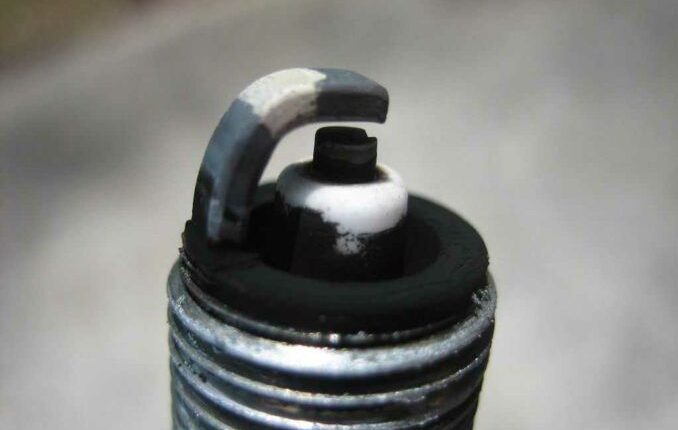A burnt spark plug will greatly affect the engine, causing the car to lose fuel (reduces fuel combustion efficiency by up to 30%), difficult to start, and vibrate. In order to detect the problem early and “catch the disease” in time, car owners need to know how to recognize burned spark plugs to have the proper solutions. Let’s find out together!
Contents
What Do Spark Plugs Do In A Car?
A spark plug is a part of the ignition system, which plays an important role in the operation of the car engine. Automotive spark plugs have the effect of generating an electrical spark between the center electrode and the electrode of the grounding side to help ignite the fuel in the cylinder.
With a gasoline engine, creating an ignition requires three elements: oxygen, fuel, and heat. When the cylinder performs the intake stroke, it sucks in the air including oxygen. The engine has a direct fuel injection system. Spark plugs help generate heat. As a result, the fuel mixture is locked to generate work to help the engine move.
Spark plugs provide heat in the form of small sparks. This spark has a voltage of 5 kV – 45 kV (depending on the vehicle) generated from the spark plug under the control of the engine control module (ECM). Sparks are caused by electrical charges jumping between the two terminals of the spark plug. The heat generated from 4,700 to 6,500 degrees Celsius helps ignite the air-fuel mixture, thereby pushing the piston to help the crankshaft move.
>> Read more: Guide to Understanding Spark Plug Heat Ranges

A Burnt Spark Plug: 5 Symptoms You Can’t Ignore
A car engine is a complex machine. Performance, fuel economy, and reliability depend on a consistent supply of air, fuel, and spark. Here are 5 signs that a burnt spark plug. Before exploring detailed symptoms, many drivers have a question:
What does a burnt spark plug look like?
Spark plug looks burnt: how can I know? You can easily spot the signs of a burnt spark plug when you notice blisters on the insulator tip, white residue or molten electrodes. The cause of the above phenomenon is due to automatic ignition causing overheating, the spark plug having an inappropriate temperature range, or other causes such as combustible deposits in the combustion chamber, damaged cylinders, and damaged valves, poor fuel quality.
5 Signs Tell You Burnt Out Spark Plug
Because a spark plug plays an important role in the engine’s process, if the spark plug fails, it will greatly affect the performance of the engine. The following are signs that spark plugs are burnt out and have a problem:
Abnormal fuel consumption
If you find that your car is consuming more fuel than usual, it is likely that the spark plug is having a problem. A report from the ASE (Automotive Service Excellence) showed that “a burnt or failed spark plug can reduce fuel combustion efficiency by up to 30%. Resulting in longer combustion times and more fuel consumption.” When the spark plug is burned, it will lose its basic functions, the ECM will not control the spark intensity or the amount of oxygen to add the right fuel level. The ECM is much more sensitive than many riders and can detect non-combustion in the cylinders. This makes the combustion process less efficient.
Flickering “Check Engine” light
When your engine or some related parts have any problems, the Check Engine light will illuminate to notify the driver. If you see the Check Engine light blinking, it is very likely that the spark plug is burnt out. However, auto experts say that there are many other causes that also cause the indicator light to light up, such as a fault in the energy sensor, catalytic converter, or fuel tank cap. Therefore, car owners should find out the cause to diagnose exactly.
Having trouble when starting the car
Proper ignition is the most difficult thing when the engine is “cold”. The ECM will add more fuel to compensate for the poor evaporation. This can make it difficult for worn spark plugs to ignite, leading to a difficult start. When the driver steps on the accelerator to accelerate the vehicle, the ECM will control the spark plug to create a spark. But if there is a problem with the spark plugs, the spark generation process can be delayed. This causes slow engine response, and in some cases, sudden engine spikes. At this time, you will experience hard or slow acceleration. When your car spark plugs burned out can make the oxygen sensor misinterpret the engine’s air volume and oxygen-to-fuel ratio. When incorrect data is sent to the ECU, it will give the wrong signal to your engine.
Engine misfiring
You can understand that engine misfiring comes from incomplete combustion (or zero combustion) Which happens inside your engine’s cylinders. Spark plugs are in direct contact with combustible gas, so it is easy to burn or wear out. This will cause the gap between the spark plug electrodes to widen, thereby weakening the spark. Or can also cause a loss of fire and an inability to ignite the fuel and air mixture. In addition, if the electrodes are covered with a lot of soot, the ignition ability of the spark plugs will be reduced.
Poor engine performance
This can be described as the engine not immediately responding properly to the “start signal” from the driver. In addition, the engine “power” can suddenly increase and be shown by the irregular engine condition. Slow response in power distribution, causing sudden jerking can indicate a spark plug problem. When accelerating, spark plugs are specifically required to provide a spark strong enough to ignite more fuel and produce more power. Burnt spark plugs may not meet the demand.
>> Related post: 6 Commons Symptoms of Bad Spark Plug Wires
How To Replace A Burned Spark Plug?

After conducting the inspection and seeing that the spark plug shows signs of burning. Drivers should replace the spark plug in time to protect the engine. The replacement of spark plugs requires supporting tools such as extension rods, spark plug opening tips, tube opening levers, and gap gauges.
Step 1: Removing the burnt spark plug
Locate the spark plugs on the engine. For L4 and L6 engines, spark plugs are mounted on the top or side of the engine in a straight line. In a V6 or V8 engine, spark plugs are located on either side of the engine.
After that, insert the tip into the extension rod and inserts the connecting rod into the tube opener lever. Loosening it gently to avoid damaging the wire and removing the spark plug from the engine.
Use a ruler to check the spark plug gap. The standard clearance is in the range of 0.7-1.5 mm, tap the spark plug tip on the wood surface to adjust when the gap is larger than the standard.
Note: It is recommended to remove the spark plug when the car engine has completely cooled down because the spark plug is very easy to get stuck while the engine is still hot, and very difficult to handle.
When removing spark plug parts, it is necessary to mark the position so that when reinstalling it, it is not confusing. Incorrect installation can cause spark plugs to be out of order, affecting fuel combustion and engine operation.
Step 2: Install a new spark plug
Clean the new spark plug installation area to ensure the best working environment for the spark plugs. Check if the high voltage wire is broken and if the insulation cover is not damaged.
Install the high-voltage wire in the correct position, to ensure that the car engine starts and does not cause vibration. It is recommended to tighten the spark plug by hand with moderate force to avoid damaging the engine thread.
Note: It is recommended to apply an anti-corrosion agent, and insulating grease to the new spark plug thread and tail to make it easier to remove the spark plug later.
When You Should Change The Spark Plug?
According to tips from experts, you should replace the car spark plugs after 40,000 – 100,000 km. However, it is difficult to have an exact number of times when it is necessary to change car spark plugs. Because spark plug life will depend on each type of spark plug, operating conditions, and maintenance time.
The best way to know when to replace car spark plugs is to check, maintain and clean car spark plugs periodically every 20,000 km. These actions do not only help prolong the life of spark plugs. And know when to replace new spark plugs, but also help the engine always operate in the best state. Because through the condition of the spark plugs, you can assess the condition of the engine.
Final Thoughts
Did you know the average spark plug can spark 27.5-110 million times over its lifetime? Each time, the spark plug loses a few molecules from the spark plug electrodes. With continuous working intensity and great pressure, spark plugs are easy to burn or wear out. Based on simple ways to identify a burnt spark plug, car owners can actively diagnose spark plug too hot symptoms. When detecting a problem with spark plugs, it is best to take the car to a service center for inspection and replacement. This is the safest and most effective solution to increase the life of your car.



